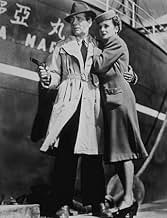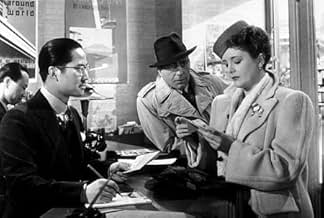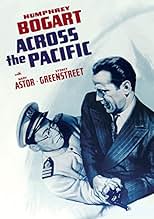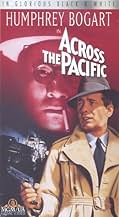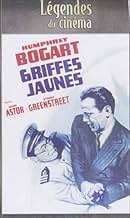En décembre 1941, l'ancien capitaine Rick Leland monte à bord d'un navire japonais qui se dirige vers l'Asie via le canal de Panama. Ses hôtes japonais se montrent intéressés par les plans d... Tout lireEn décembre 1941, l'ancien capitaine Rick Leland monte à bord d'un navire japonais qui se dirige vers l'Asie via le canal de Panama. Ses hôtes japonais se montrent intéressés par les plans de défense américains pour la zone du canal.En décembre 1941, l'ancien capitaine Rick Leland monte à bord d'un navire japonais qui se dirige vers l'Asie via le canal de Panama. Ses hôtes japonais se montrent intéressés par les plans de défense américains pour la zone du canal.
- Réalisation
- Scénario
- Casting principal
- Récompenses
- 1 victoire et 1 nomination au total
- Joe Totsuiko
- (as Sen Young)
- Sam Wing On
- (as Lee Tung Foo)
Avis à la une
It may be unfair to compare "Across the Pacific" to a lucky shot like "The Maltese Falcon," but this film invites the comparison. Not just the same performers but similar lines -- "You're good, Angel, very, very good." But in Falcon the actors fit their fictional characters like enzymes accommodating themselves to a substrate. Here they are just actors playing familiar roles: the obese villain, the officer who's dishonorable discharge is faked so he can go undercover (Gary Cooper could have done as well, and in fact DID in a later movie), the innocent woman made to look bad because the enemy has imprisoned her dissolute father. The Japanese are all plain-vanilla bad guys, even the familiar young one who makes amusing wisecracks in American slang. And all the Japanese have real names like Tong, Chan, Loo, Fong, and Ahn. (To be fair, the last one is Korean, not Chinese.)
If the characters are not nearly as much fun to watch as in "The Maltese Falcon," the plot is no more than a simple war-time mystery involving secret information that the Japanese want to use to start the war by torpedoing the locks of the Panama Canal. Actually, the Japanese did develop such plans later in the war. They intended to deliver a handful of torpedo planes to the vicinity of the Canal in huge submarines, which were available. The planes were not, and the plans folded when the war ended.
In the movie, the characters move from New York to Canada, then board a Japanese steamer, back to New York, then to Panama, where they disembark. They travel from the Atlantic side of the canal to the Pacific -- but they never make it across the Pacific.
You're going to really enjoy this film if you've seen modern Pulp adventures like the Indiana Jones trilogy or Sky Captain (though don't expect to see ANY mystical/sci-fi elements involved). This has it all: a hard-boiled hero, exotic locales, constant plot twists and turns, colorful villains, and a mysterious woman.
Bogart, as (almost) always plays the same character he always plays. but boy, does he fit in SO well into this film. Mary Astor, while not the pretty face that she was built up to be here and in "The Maltese Falcon", gives another great performance, and unlike Bogart, she was always able to give characters in a similar vein (in this case, the mysterious woman), each their own personalities. Her Alberta Marlow is not at all like "schoolgirl" Brigid O'Shaughnessey, but (at least openly) tougher, a perfect match with Bogart during their exchanges of dialogue, while remaining to be extremely ambiguous, never making sure whether or not she's an ally or a femme fatale. When all is revealed, looking back on it things made perfect sense with her character's attitude.
Sydney Greenstreet adds another great villain to his own rogues gallery. Here he's a man obsessed with Japanese culture and way of life, so much that he has become apart of and accepted by "the enemy". Victor Sen Young, who played a great shark grinned scumbag in "The Letter", does good here, looking very happy that he at least was able to speak coherently for once in a motion picture.
Huston's direction is really worth looking at, especially visually stunning during a sequence at a movie theater. Without his obvious presence and Bogart, this film would have just been another propaganda story of espionage. Sadly, when he had to leave the film for war duty, the final scenes were shot by otherwise competent (but nothing special) director Vincent Sherman. The final 15 minutes seem extremely out of place with the rest of the film, and its a shame Huston wasn't around a little bit longer to round up what could have been a quintessential piece of a feature 40's pulp movie.
Worth seeing, its a film that falls short of greatness, but man is it entertaining.
Rick Leland (Humphrey Bogart) is a disgraced military man with dubious loyalties. He gets on a Japanese ship that is sailing to New York City, the Canal Zone and the Orient. While onboard, he becomes familiar with the other passengers: a western businessman named Dr. Leland (Sydney Greenstreet) who has a penchant for all things oriental and a smalltown woman named Alberta (Mastor Astor) who is taking a pleasure cruise.
But we sense all is not as it seems. Will Rick sail off into the Japanese sunset, bitter at the country that snubbed him? Will the doctor reveal an insidious intent? Will Alberta prove to be more than a romantic foil for Rick?
The action takes place not long before the U.S. would be forced to enter the war. Tensions are high. Eventually there is gunplay and all motives are revealed. Along the way, ATP proves to be an interesting film. The ending reminded me of another film that would follow in 1959--North by Northwest. ATP is a high stakes game of cat and mouse that coexists with a lighthearted romance.
My one complaint is that Mary Astor is not an actress I think would inspire lust in Bogart's Rick. Someone like Rita Hayworth would better fit the bill.
Le saviez-vous
- AnecdotesDirector Vincent Sherman met with John Huston just before Huston left the project to join the United States Army Signal Corps to shoot documentaries for the war effort.
The two directors conferred just before they were about to shoot the scene in which Leland is trapped in the movie theatre and three assassins are trying to kill him.
"How does he get out?" Sherman asked. Huston replied, "That's your problem! I'm off to the war!"
John Huston then went off to join the war effort before the film was finished, taking the film script with him, explaining "Bogie will know how to get out." The studio's solution to the problem was to discard Huston's footage of the impossible dilemma and write a new scenario. Vincent Sherman directed the final scenes.
- GaffesThe background for the opening titles is a map of the Panama Canal. The orientation of the map and the compass is correct, but the labeling of the map is incorrect. In fact, the Atlantic end of the canal and the city of Colon are at the upper left (Northwest), and the Pacific end of the canal and Panama City are at the lower right (Southeast). The map is correctly labeled behind the closing credits.
- Citations
Rick Leland: [comparing his gun to Dr. Lorenz's, which he points at him] Remember: mine is bigger than yours!
- Crédits fousOpening Card:
Governor's Island
New York
- Versions alternativesAlso available in a computer colorized version.
- ConnexionsFeatured in Frances Farmer Presents: Across the Pacific (1959)
Meilleurs choix
- How long is Across the Pacific?Alimenté par Alexa
Détails
- Date de sortie
- Pays d’origine
- Langues
- Aussi connu sous le nom de
- Across the Pacific
- Lieux de tournage
- Société de production
- Voir plus de crédits d'entreprise sur IMDbPro
- Durée1 heure 37 minutes
- Couleur
- Rapport de forme
- 1.37 : 1
Contribuer à cette page



